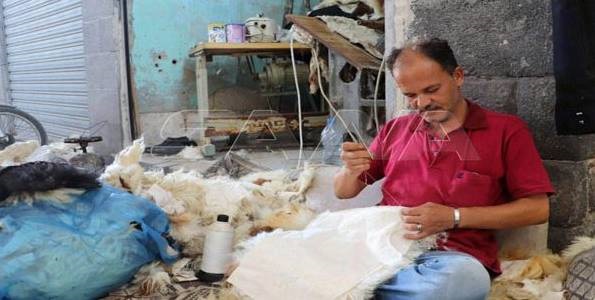The heritage markets in the center of the old city of Homs have a special image in popular memory, as the rehabilitation of these markets and the return of a number of traditional professions to them have restored life to these markets, making them a destination for a large number of visitors. One of these markets is the Fur Market or, as the public calls it, “Al Furwatiyeh ”, according to a type of dress and furnish that many still want to own.
The Fur Market, which connects three markets, namely copper, tailors and carpenters, contains dozens of shops that stand in two compact rows. A small square intercedes the market. Its floor, as well as the walls of its shops, are made of black basalt stones. It contains shops of a group of craftsmen who inherited the profession of making various kinds of fur, the father from the grandfather.
Nidal Melisso, who has been working for thirty years in this profession, says that he sews the fur parts as a stage of work after cleaning and washing them with salt and alum to remove what is stuck with it, then begins the stage of tanning, sewing and packing it with cloth from the outside, indicating that this profession requires a lot of patience and perfection amid the demand for buying fur despite the high prices, starting from SYP 50.000 to 150.000 for each fur.
Artisan Ghannam Al-Farra , said that he produces all kinds of fur, including clothing and outfits to homes and some tourist and heritage buildings. “Our work mainly needs summer heat and drought for the leather to be manufactured”, he added.
Ziad Al-Hussein, who owns a store for fur products, says that after washing the skin with salt and alum and sterilizing it, the leather passes through a handy machine to soften and clean it and increase its whiteness , as a prelude to sewing it, whether furniture or clothing. “Our profession is usually active on holidays and on different occasions when people offer sacrifices, as large numbers of skins are available for customization, he clarified.
 Dr. Abdel-Rahman Al-Bitar, Head of the Historical Society in Homs, said that the Fur Market is part of the group of organized heritage markets, as the markets were distributed according to each , trade and craft, indicating that each craft has its own market that reflects one of the methods of civilization development that characterize Arab cities, noting that “Al-Furwatiyeh” is an important market that attracts many visitors, especially the people of the villages and Al-Badia, “the desert”
Dr. Abdel-Rahman Al-Bitar, Head of the Historical Society in Homs, said that the Fur Market is part of the group of organized heritage markets, as the markets were distributed according to each , trade and craft, indicating that each craft has its own market that reflects one of the methods of civilization development that characterize Arab cities, noting that “Al-Furwatiyeh” is an important market that attracts many visitors, especially the people of the villages and Al-Badia, “the desert”
Al-Bitar pointed out that the market was built in the late nineteenth century, where the markets had an inspector supervising them in all respects and managing their administrative and legal affairs and each profession had a sheikh called “Sheikh al-Kar”, the profession master.
Amal Farhat

